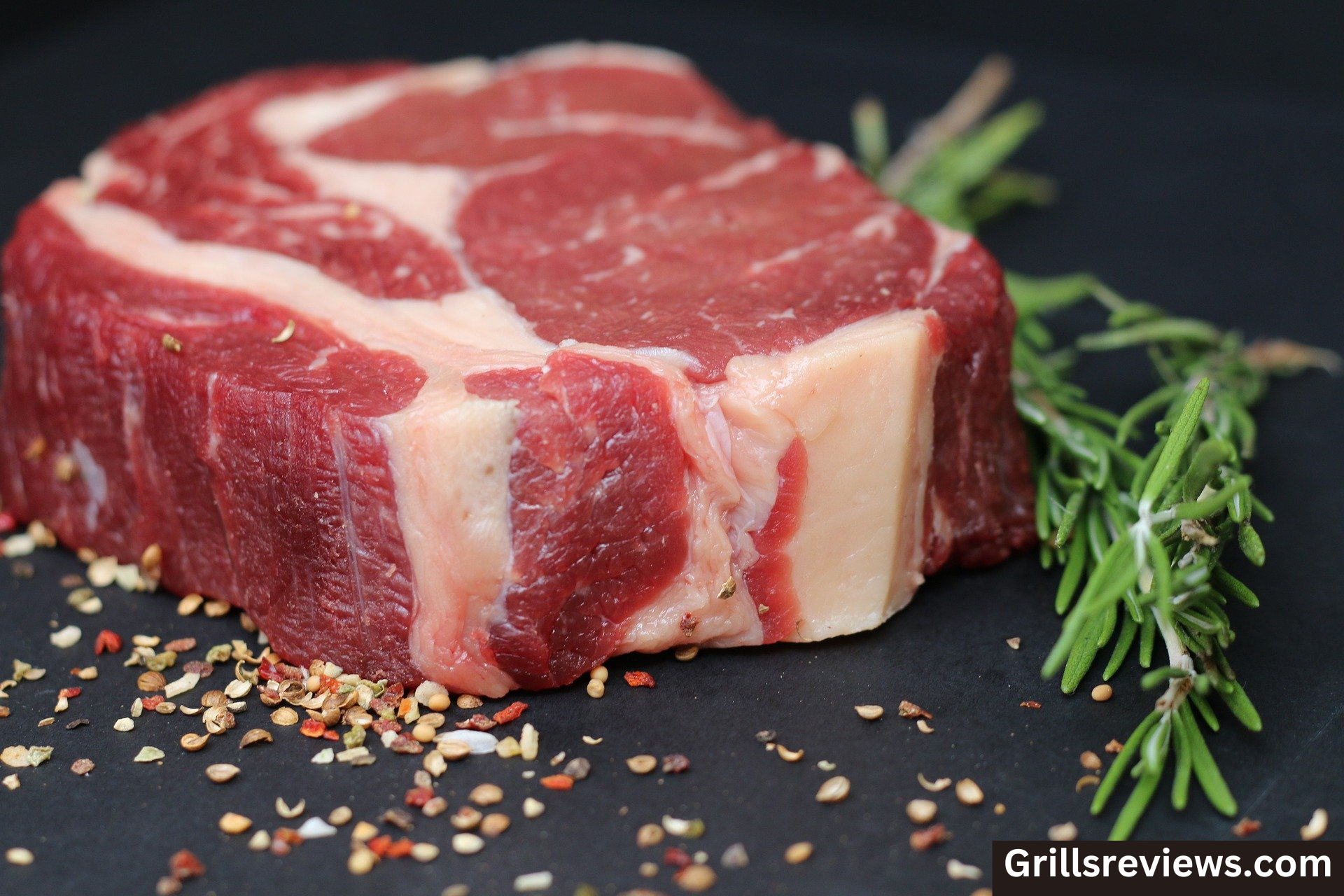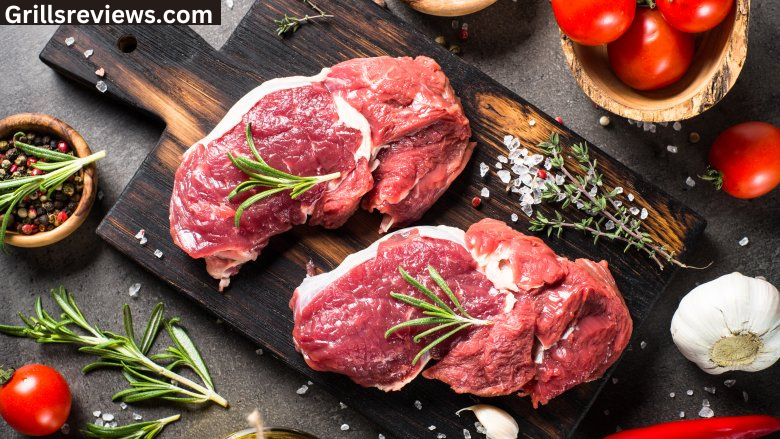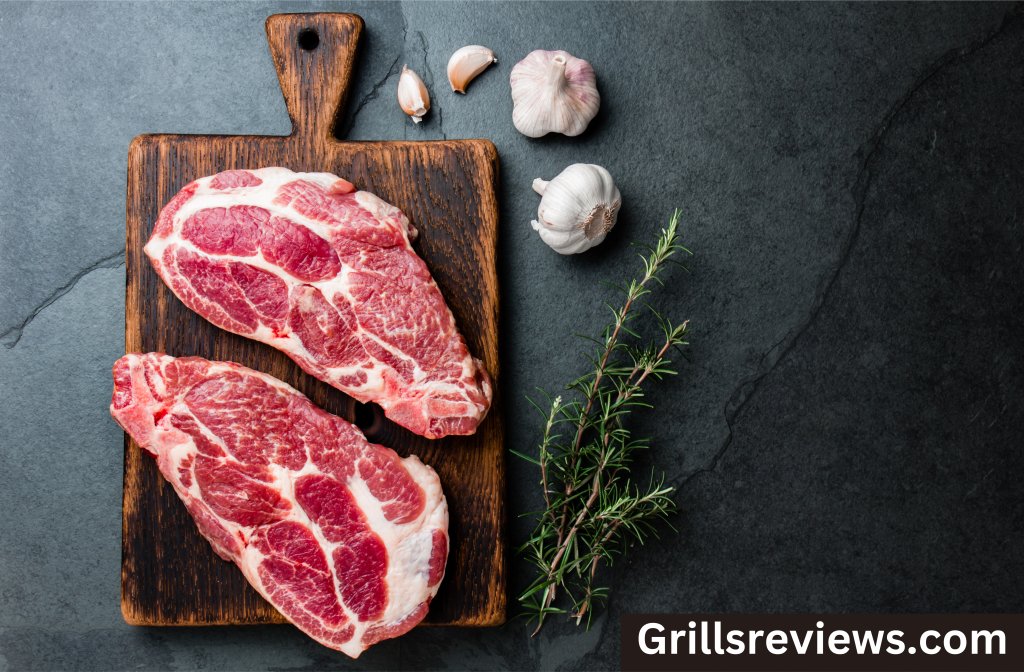Can You Eat Raw Steak? (How It Will Affect You If You Do)

One of the most well-liked foods in the world is steak, which may be eaten medium-rare or well-done. Many people disagree on whether eating raw beef is safe. But there is no reason why you can’t eat your favorite steak raw, as long as you take the necessary safety precautions.
How uncommon, though, is too rare? Is it safe to eat raw steak? We have the answers to these queries, if you’re asking them.
This post will discuss the dangers of eating raw meat as well as some safety advice for when you do decide to indulge.
Can You Eat Raw Steak?
I often get the question, “Can you eat steak raw?” The occasional raw steak can be consumed without making some people ill. Raw beef can, however, contain dangerous germs that result in food poisoning, which can have adverse effects on the digestive system like bloating, vomiting, nausea, or diarrhea.
Can Raw Steak Be Eaten Safely?
Since it is obvious that certain dangerous germs may dwell on the surface, the majority of people would undoubtedly recoil at the prospect of consuming a raw steak. Infections including listeria, salmonellosis, and E. coli poisoning can result from consuming raw beef.
Beef must be cooked to a minimum internal temperature of 160 °F and let rest for a few minutes in order to guarantee that the majority of dangerous germs are eliminated.

When you consume raw meat, you face the risk of coming into contact with these dangerous germs, which might potentially cause serious damage to your digestive system. This may have had some unfavorable side effects that could have been prevented.
However, it is a recognized truth that you may order a number of meals that are essentially raw beef, steak, or other meat. These foods may be superb and expensive, but they are regarded as delicacies.
The final piece of advice is to be aware of the hazards associated with eating raw beef before you ever attempt it. When it comes to your health and the health of your family, it is always preferable to err on the side of caution.
Health Concerns of Eating Raw Steak
While many individuals occasionally love eating raw steak meals, it is crucial to remember that there is a significant likelihood that they might be exposed to dangerous germs that can cause stomach trouble. In some circumstances, the severity of the food poisoning might swiftly worsen.
Continue reading if you’re interested in learning more about the different health issues related to eating raw steak.
Parasites
An animal’s intestines may occasionally come into contact with different portions of the flesh during the slaughtering process. The meat intended for human consumption would get infected with parasites if the animal had them.
You probably already know that when this occurs, parasites dig themselves into the flesh rather than remaining on the surface. The danger of exposure is quite significant if this meat is subsequently sold to butchers and other marketplaces and then purchased by an individual.
If this is the situation and you decide to cook your meat according to one of the instructions for raw steak, you run the risk of contracting parasites. Remember that parasites often multiply quickly, so an issue that may initially seem minor may quickly become more serious.
Parasite exposure can result in a number of unpleasant symptoms, including nausea, vomiting, diarrhea, cramps, and more. These parasites can occasionally result in high fevers and even severe conditions, depending on their intensity.
Salmonella
Animals frequently carry the bacterium Salmonella in their gastrointestinal tracts without suffering any serious consequences. However, when this is introduced to people, it can result in a variety of food poisoning symptoms.
Most microorganisms are eradicated when your steak is cooked to the correct temperatures, eliminating any risk. But if you consume raw steak, you face the risk of contracting Salmonella, which can cause mild to severe food poisoning.
The major concern is that Salmonella can spread to other areas of your body, even though exposure might result in some unpleasant symptoms. Your circulation, bones, and other organs can all easily become infected with the bacteria, which can eventually lead to serious sickness.
E. Coli
This bacterium may have existed without causing harm for a long time and is present in the intestines of both people and animals. E. Coli, however, can occasionally produce a wide range of unpleasant symptoms.
Once more, people can get E. coli infections from eating beef that has had its intestines or other infected organs exposed. This can then spread to those who eat the meat.
However, the risk is diminished when the steak is cooked to the appropriate levels, as the intense heat can eradicate any bacteria. You face the danger of contracting E. Coli if you opt to cook your steak to be ingested raw.
Listeria
Another bacterium that may infect you and make you sick as a result of pollution is listeria. This bacterium is frequently found in cows, poultry, and, in some circumstances, even soil.
Unlike other bacteria, Listeria does not cause symptoms or let you know you have an infection for nearly 24 hours after ingesting contaminated meat. You may suffer mild to severe symptoms after the pathogen has infiltrated your body.
The bacterium may occasionally cause fever, body pain, nausea, and vomiting. The symptoms can become exceedingly severe in those with weakened immune systems or in pregnant women, and they have even been known to result in miscarriages or premature births.
Why Do People Eat Steak That Is Raw or Partially Cooked?
The texture and flavor of such meat are the main reasons why people choose to consume raw or only partially cooked steak. A medium-rare steak, for example, is far more juicy, delicious, and tender than a well-done steak. Let’s first discuss what happens to the meat while cooking in order to better grasp this.
Depending on the cooking time and temperature, chemical reactions during the cooking process cause the meat to change color, shrink, lose moisture, and break down fat. As a result, the meat can either become tough or soft.
In the case of steak, prolonged cooking results in harder, chewier meat. Because of this, it is not advisable to cook a steak until it is well done (reaches an internal temperature of 160°F), as this results in a dry, flavorless steak as opposed to one that has been cooked rare or medium.
But it’s crucial to remember that eating raw meat has higher health risks because of possible impurities. Therefore, to lower the danger of contracting a foodborne disease, it is advised to only eat entirely raw meat at establishments that manage it correctly.
Who Can’t Eat Raw Steak?
Completely raw meat should be avoided by older people, children, pregnant or nursing women, and anyone with immunological or digestive system disorders, according to medical journals.
How Can You Eat Raw Steak Safely?
You can consume raw steak without becoming sick, despite the fact that doing so can result in numerous nasty illnesses. Raw beef consumption is more commonplace than cooked steak consumption in many nations and cultures.
Are you unsure of the safety of consuming raw steak? Learn some safety advice by continuing to read.
1. Pick Your Source Carefully
The first thing you should know is that picking a source for your purchase should be carefully considered when it comes to cooking and consuming raw steak. This is due to the fact that well-chosen raw steak can aid in lowering the risk of food poisoning.
The majority of eateries and those that cook raw steak meals frequently do not purchase their meat options from the neighborhood grocery store. Despite the fact that the meat there is often excellent for other recipes, you will need superior quality for dishes that are served raw.
Numerous studies have demonstrated that selecting beef from a reliable source will lower your exposure to dangerous microorganisms. In other words, if you choose wisely, you can cook and consume your raw steak without having to worry about becoming sick.
To ensure that your beef comes from a single animal, most people advise purchasing it straight from a butcher. You have a greater danger of becoming sick from eating food-borne illness after you start mixing meat from different sources.
If you’re intending to make a meal with raw steak, you might want to think about buying beef from organic, grass-fed animals. This is a result of their lack of exposure to the same toxins and antibiotics as others.
2. Store Your Steak Properly
You must make sure that you are preserving your steak appropriately after getting it from a reliable vendor. To kill as many bacteria as possible, it is advised to keep raw steak chilled at a temperature below 40 °F.
Many individuals, especially those who don’t intend to consume the beef right away, may put it in the freezer straight away in the mistaken belief that doing so will lengthen its shelf life. In actuality, the longer raw beef is frozen, the worse the quality will be.
Additionally, you’ll be exposed to fewer germs and poisons if the meat is kept in the refrigerator at the right temperature. However, bear in mind that even at colder temperatures, the risk of some hazardous germs growing increases the longer it is stored.
3. Take Care Not to Eat a bad steak
As was already indicated, it is ideal to cook and consume your raw steak as soon as you can after buying it. This is because the longer food stays, even in a refrigerator, the more germs it is exposed to and the greater the chance that it may spoil.
Keep in mind that it is crucial to consume raw steak meals when they are still unbelievably fresh. By doing this, you can lessen your chance of getting sick from dangerous germs and other potential diseases.
The majority of the time, determining whether your steak has gone bad is not difficult. The color of the steak is typically the first clue that it might not be as fresh as you might like it to be, particularly if you plan to prepare it raw.
In addition, the texture has the potential to form a slimy residue that lies on top and may be felt as well as seen. If the flesh in your steak feels slimy, it has probably gone bad and shouldn’t be eaten.
4. Follow The Recipes Exactly
It is advised that you only consume raw steak at a restaurant where the chef has received training in proper meat handling techniques because it may be a dangerous endeavor. This is due to the possibility of becoming very ill if sufficient care is not taken.
Additionally, it is advised that you avoid attempting to make the dishes at home unless you have received training in proper meat handling techniques. Any raw steak grilled incorrectly might cause you to have really nasty side effects for a while.
If you do decide to create meals using raw steak at home, you need to make sure that you are using the suggested recipes and taking the necessary precautions to protect both you and any other diners. This implies that you should investigate recipes and make sure you are closely following the directions.
What Raw Steak Recipes Should You Try?
Even though eating raw steak might have certain drawbacks, many individuals savor the many international cuisines. Although it may not be as well-liked in the US or the UK, there are many other nations that offer meals with raw steak that you might want to try.

Discover some of the most popular raw steak meals by reading on.
1. Ossenworst
In this unusual delicacy, seasoned raw beef is stuffed into a sausage before being thinly sliced. Despite the fact that this dish contains both beef and sausage, the robust flavor of the sausage tends to blend with the spice of the beef.
2. Beef Carpaccio
This Italian appetizer has raw beef that is cut into small slices and often served with crackers. The Carpaccio may occasionally be topped with capers and onions and drizzled with olive oil and lemon juice, depending on the restaurant you are eating at.
3. Steak Tartare
Served with tartare sauce, this meal of raw steak first gained popularity in France in the early 20th century, giving rise to its name. It is frequently served on a slice of bread with a raw egg yolk on top and is made with raw, chopped, or minced beef.
4. Pittsburgh Rare Steak
Even though it’s not very common to eat raw steak in the United States, this recipe will definitely make you reconsider eating raw beef. The surface of this steak is seared and blackened at a high temperature, and the interior is left raw.
These are some of the most popular steak meals that you can get in numerous restaurants all around the world; however, this is by no means a full list. Some folks like making these meals at home.
What Are the Symptoms of Bad Raw Steak?
The decision to consume raw steak is often more subjective than objective. However, it’s crucial to remember that even with the greatest care, you still face the danger of getting food poisoning.
Due to improper preparations while making it themselves at home, many individuals feel sick after consuming raw beef. This might imply that they didn’t choose their steak from a reliable supplier in some circumstances. Additionally, it’s crucial to make sure the meat you use is fresh.
The most typical indication that raw steak has deteriorated.
- Foul odor
- Slimy texture
- Bitter or sour taste
- The coloring is off
To be safe and maintain your health, you might want to throw away your raw steak if you think it has gone bad. The best thing you can do to prevent hazardous bacteria from forming on your raw steak meal is to cook it as soon as possible after acquiring it.
FAQs
What Kind of Steak Can be Eaten Raw?
The answer to the question “Is eating raw steak safe?” is often “No.” While serving top-quality meat that has been handled and kept safely, premium restaurants that offer raw beef adhere to stringent quality requirements. However, since there is a greater chance that it will contain hazardous bacteria, it is best to proceed with caution while eating any raw beef.
Does Raw Steak Have a Pleasant Flavor?
The liking for totally raw steak varies greatly from person to person. It’s obvious that not everyone will enjoy it. Depending on the cut, raw steak can be juicy and tender, yet most steak lovers might find it to be overly chilly and occasionally chewy. Start with a blue steak or a Pittsburgh-style steak if you’re curious about trying raw steak.
Is there a Blood-like Substance in the Uncooked Steak?
Blood is not the crimson liquid in uncooked steak, though. It is made up of water and a protein called myoglobin, which, when exposed to oxygen, gives the meat its red color. As soon as the flesh is exposed to air and heat, its color changes to varying shades of red or brown.
Is Pink Steak Safe to Eat?
Why not ask, “Can you eat steak raw?” instead? Choose beef that is medium-rare to medium-well done if you want to be safe. Steaks are cooked to an internal temperature of 130–135 degrees for medium-rare and 140–145 degrees for medium.
When the steak has been handled and cooked correctly, it should have a tiny bit of pink in the center that is normally safe to consume.
Can I Order Raw Steak in a Restaurant?
Still uncommon in the US and UK is asking for a steak to be served uncooked. The majority of eateries and steakhouses will be cautious about offering raw meat to patrons due to the potential backlash.
The best course of action is to call the restaurant ahead of time and, if they won’t offer you a raw steak, ask if they’ll cook it as blue as possible as a close second.
How Can I Tell If Raw Steak Is Bad?
Raw beef dishes are popular due to their light and delicate flavor and texture. Always err on the side of caution and avoid eating raw beef if it has a clearly bad sour smell, an unpleasant sour or bitter taste, or a slimy texture.
Final Thoughts
At the end of the day, you may surely eat raw steak if you so wish, but you must make sure that you follow all the safety instructions. Making sure the beef is of high quality is part of this.
You must also decide if you will try to prepare a dish with raw steak on your own or whether you will go with a dish created by a trained chef. Most people advise eating it in a restaurant where you know that it is being prepared by a skilled individual.
When preparing raw steak recipes at home, one of the most crucial things to keep in mind is to constantly inspect your meat before using it. The last thing you want to do is increase the danger of the meat being bad on top of the hazards you already face when consuming raw meat.
Related Posts

How To Cook Ribs On The Grill (5 Easy Steps)

How Much Ham Per Person Calculator (And Leftover Tips!)
